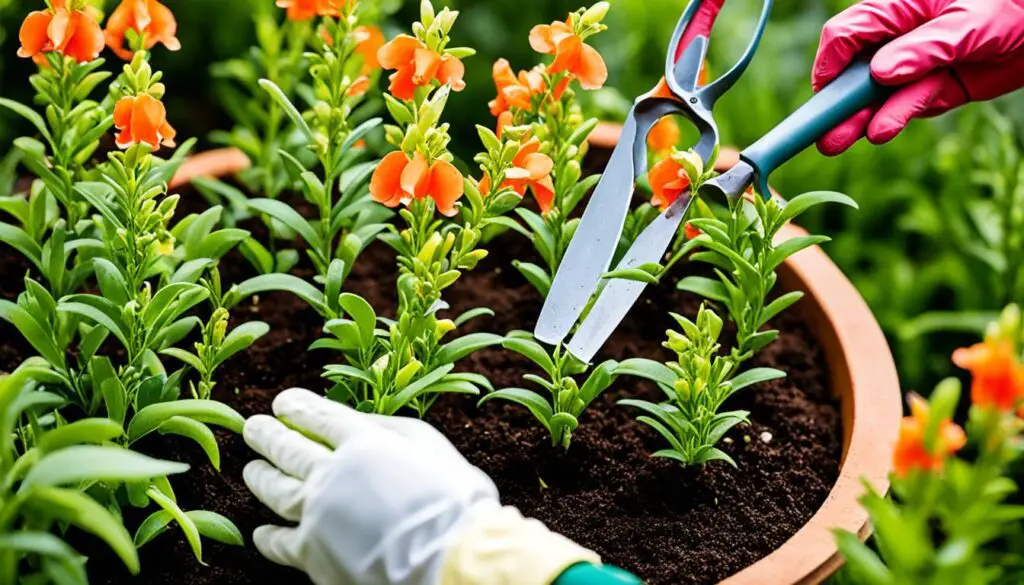I’ve always loved the snapdragons in gardens. These vibrant flowers are perfect for classic gardens, adding color to borders, boxes, and containers.
Their name comes from their flower heads, which look like a dragon’s snout and open and close when bees visit.
Snapdragons vary in size, from tiny dwarfs to tall spires. Breeders have created many types, including trailing and creeping ones.
Whether you’re new to gardening or experienced, growing snapdragons is rewarding.

Key Takeaways
- Snapdragons are short-lived perennials that are commonly grown as annuals
- They come in a wide range of sizes, from 6-inch dwarfs to 4-foot tall spires
- Snapdragons are deer resistant and grow well in sunny areas
- Proper care and maintenance can encourage snapdragons to return year after year
- Snapdragons require well-draining soil, regular watering, and a neutral pH
Understanding Snapdragons: Colorful Cool-Season Bloomers
Snapdragons are the stars of the cutting garden. These flowers, with their unique “dragon-like” blooms, are not just pretty.
They are also tough. As a gardener, I’ve learned why snapdragons are essential in my garden.
What Are Snapdragons?
Snapdragons, known scientifically as Antirrhinum majus, are annuals that stand out with their beautiful flowers.
They love the cool seasons and can grow well in many places. This makes them perfect for rock gardens, containers, and cutting flower beds.
Growing Habits and Requirements
- Snapdragons need full sun, at least 6 hours a day, to bloom well.
- They do best in soil that drains well and is rich in organic matter. They also need about 1 inch of water each week.
- These plants do great in cool weather, liking nights around 40°F and days around 70°F.
- Snapdragons can handle light frost and average humidity, making them tough for any garden.
- For cutting flowers, snapdragons might need a 10-10-10 fertilizer when they’re in bloom.
Snapdragons are known for their long-lasting blooms. Harvested at the right time, they can stay fresh in a bouquet for up to 2 weeks. This makes them a top choice for cut flower lovers.
Although snapdragons aren’t from North America, they’ve become a big part of our gardens. They do well in many conditions, from rock gardens to cutting beds. Their bright colors are a joy to see.
“Snapdragons are one of my favorite cut flowers! They have an excellent vase life, sometimes lasting 2 weeks if harvested at the proper stage.”
Grow A Snapdragon and Care: Planting and Maintenance
Growing snapdragons from seed is rewarding but needs some extra care. To help your snapdragon seeds germinate, keep them in the freezer until planting time. This cold period mimics their natural need for cold temperatures before sprouting.
Starting from Seed
Snapdragon seeds are tiny, almost like dust. When sowing, wear glasses to see clearly! I sow two seeds per cell or spot – no thinning needed if both sprout.
Use a damp toothpick to place seeds in the soil, then cover them lightly with soil.
Start snapdragon transplants 8-10 weeks before your area’s last spring frost. This ensures they grow well.
Planting and Spacing
Transplant snapdragons 6-9 inches apart for best growth. This spacing helps them grow taller and stronger. Once they’re up and growing, pinch back the tips to encourage branching.
Pinching means cutting off the top part of the plant, leaving a few leaves. This makes the snapdragon produce more stems and flowers. Some gardeners leave a few plants unpinched for an early bloom, then pinch the rest to keep flowers coming longer.
FAQ
What are Snapdragons?
Snapdragons are popular garden flowers that are often grown as annuals. They are a key part of classic gardens. They can be found in mixed borders, flower boxes, and patio containers.
What makes Snapdragons unique?
Their name comes from the dragon-like shape of their flowers. These flowers can even snap open and close, helping pollinators reach the pollen inside.
How do Snapdragons get pollinated?
Big bumblebees are key to pollinating Snapdragons. Smaller bees can’t open the flower’s “jaws” to get to the pollen.
What are the different varieties of Snapdragons?
Snapdragons vary in height, from a few inches to over 4 feet tall. They come in many sizes and types, including dwarf and trailing varieties. Breeders have created many new types over the years.
Why are Snapdragons great for cutting gardens?
Snapdragons are perfect for cutting gardens. They last well in vases, sometimes up to 2 weeks if cut at the right time.
Where do Snapdragons grow best?
Snapdragons thrive in full sun outdoors. They do best in cool weather, with nights around 40°F and days around 70°F. They can handle a light frost and need average humidity.
How do you start Snapdragons from seed?
Starting Snapdragons from seed can be a bit tricky. I keep the seeds in the freezer until I’m ready to plant them. This helps them germinate better, mimicking their natural cycle.
How do you plant and care for Snapdragons?
Plant transplants 6-9″ apart for best growth. This spacing helps them grow taller. After they start growing, “pinch back” the plants to make them branch out and bloom more.



